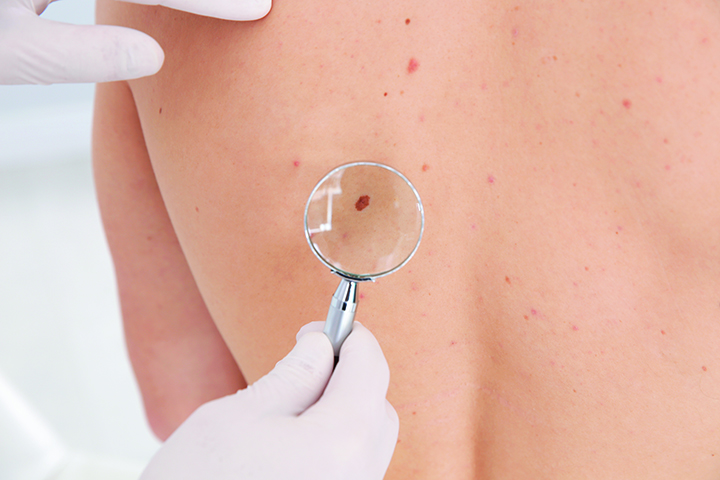By now, everyone knows sun worshipping can have dire health consequences. It’s no longer news that malignant melanoma cases are on the rise and that excessive sun exposure is a major reason.
But that doesn’t mean we’re all taking adequate precautions against the sun or checking our own skin for suspicious moles. Nor does it necessarily mean all healthcare professionals are adept at recognizing the signs of this skin cancer. That’s a shame, because when detected and treated early, malignant melanoma is curable. And using common-sense preventive measures may help prevent the disease in the first place.
Malignant melanoma is a cancer of the melanocytes, the body’s pigment-producing cells, located mostly in the skin. The disease occurs in four types, which vary in appearance, incidence, and location.
Incidence
The incidence of malignant melanoma has been rising every year. It increased approximately 6% from 1971 to 1980. Since 1981, it has risen about 3% annually. In the United States, it has more than doubled in the past 30 years. Although malignant melanoma accounts for just 4% of all skin cancers, it causes most skin cancer deaths worldwide. Since 1973, deaths have jumped 50%, with a concentration in certain demographic groups. In 2007, the United States will see an estimated 60,000 new cases and more than 8,000 deaths from the disease.
Malignant melanoma is primarily a Caucasian cancer. African Americans and Hispanics have a much lower incidence, although their mortality is higher because the disease is more advanced by the time it’s diagnosed. (Darker skin takes longer to show noticeable changes; also, melanoma is more likely to occur in remote body areas, such as the soles, in darker-skinned people.)
Melanoma is slightly more common in males. Median age at diagnosis is 53, but the disease occurs in everyone from teenagers to the elderly.
Risk factors
Some melanoma risk factors are modifiable. Exposure to the sun and artificial ultraviolet radiation sources, such as tanning booths and lamps, is the leading modifiable risk factor. The highest melanoma incidence occurs in geographic areas where sun exposure is greatest, such as Australia, New Zealand, and the desert southwestern United States. Intense sun exposure and burns with or without blistering before age 15 are h2 risk factors for skin cancer development later in life.
Immunosuppression may be modifiable to some extent. Patients taking immunosuppressant drugs require increased surveillance for melanoma, with skin checks every 6 months.
Nonmodifiable risk factors include skin type, genetic factors, and multiple or dysplastic nevi (moles). People whose skin burns easily and who never or rarely tan are at higher risk; many of them have blue or green eyes, red or blonde hair, and fair skin with multiple nevi.
A personal or family history of the disease also increases risk. Having one first-degree relative with melanoma doubles the risk of developing it. In up to 10% of cases, genetic predisposition is a key factor.
Assessment
Typically, the earliest sign of melanoma is a change in the shape, size, color, or feel of an existing mole or emergence of a new mole. Some melanomas bleed or itch; most have a black or blue-black area. A common way to assess for melanoma is the ABCD method.
Diagnosis
When a skin lesion is suspicious, a biopsy is performed to obtain tissue specimens for examination. In a punch biopsy, the specimen is obtained from the epidermis or, less often, from the dermis and subcutaneous tissue (the deepest skin layer). Incisional and excisional biopsies both remove a full-thickness skin portion.
Once a suspicious lesion is confirmed as malignant melanoma, the dermatologist or surgeon performs a total excision in stages. After each stage, the margins are examined for spread and metastasis; excision continues until the pathologist verifies that the margins are disease free. Then the tissue is staged to help determine the next level of treatment. In some cases, the patient may need to undergo a sentinel node biopsy or more extensive surgery to excise satellite areas of malignant cells.
Classification and staging
To determine the degree of skin invasion (how deeply the melanoma has invaded the skin), the tumor is studied carefully to assign a stage. Tumor staging guides treatment and h2ly influences prognosis and survival. The Clark and Breslow classifications may be used to determine invasion level.
Once these classifications are assigned, TNM classification is made:
• T stands for tumor thickness.
• N stands for nodes, denoting how many lymph nodes in the area directly adjacent to the tumor contain micrometastases.
• M denotes metastasis. The most common metastasis sites for malignant melanoma are the lung, brain, bone, and liver. Laboratory and radiologic tests help detect distant metastases.
The oncologist considers laboratory and radiologic test results together with biopsy findings and tumor classification and staging to determine the melanoma stage. Some clinicians also may use the American Cancer Society’s staging system:
• Stage 1: Melanoma is limited to the skin’s surface layers and is less than 1.5 mm thick.
• Stage 2: Melanoma is limited to the surface layers but is more than 1.5 mm thick; or satellite melanoma cells exist in the skin near the main lesion.
• Stage 3: Melanoma cells have spread into nearby lymph nodes or are found in the skin more than 5 cm away from the main lesion.
• Stage 4: Melanoma cells have spread to other organs, such as the lung, liver, or brain.
• Recurrent melanoma: Melanoma that has returned after initial treatment.
Treatment
Treatment is based on tumor staging and classification. Surgery is the definitive treatment for all melanomas. The surgeon excises the lesion and may perform biopsy of the sentinel node (the first lymph node to receive lymphatic drainage from the tumor) to determine if the disease has spread to the nodes; a positive result warrants lymph node excision.
To kill any cancer cells remaining after surgery and increase the chance of cure, surgery may be augmented with radiation, chemotherapy, biotherapy, or a combination. Chemotherapy is most often used for symptom relief and life extension in patients with advanced disease; the most commonly used agents are cisplatin, vinblastine, and dacarbazine. Radiation may be recommended for adjuvant treatment of regional metastasis and palliative treatment of distant metastasis.
Biotherapy
Some patients may benefit from interferon alfa-2a or other forms of biotherapy. An immunomodulator, this drug helps the immune system recognize and destroy cancer cells. It’s used as adjuvant therapy for patients at high risk for systemic melanoma recurrence. Patients typically receive high I.V. doses 5 days weekly for 4 weeks during the induction phase, followed by the maintenance phase during which they receive it subcutaneously three times weekly for 48 weeks. However, many patients can’t tolerate this regimen and require modifications.
Nursing interventions
If your patient is receiving drug therapy, stay alert for and report signs and symptoms of adverse effects. Interferon alfa-2a may cause flulike symptoms, fatigue, fever, chills, malaise, myalgia, headache, GI distress, and anorexia; these conditions usually resolve when therapy ends. Some patients also report alopecia (usually reversible). Mild inflammation at the injection site may occur, possibly exacerbating such preexisting conditions as psoriasis.
Because interferon affects the liver and heart, teach the patient about the importance of close follow-up by the oncologist. Monitor laboratory values, including complete blood counts (CBC) and liver function tests. If liver function values rise to more than five times the normal value, withhold the drug until these abnormalities resolve.
Rarely, interferon alfa-2a causes hypotension and tachycardia. Report these effects to the physician immediately; they might warrant drug discontinuation. To manage fatigue, advise the patient to pace activities throughout the day to conserve energy. Fatigue commonly persists as long as therapy continues; it may be difficult to manage and necessitate dosage reductions. Report changes in the patient’s status, including increasing fatigue, to the physician.
To manage flulike symptoms, instruct the patient to drink plenty of fluids, rest before and after treatments, eat small meals to minimize nausea, and get moderate exercise. Teach the patient to report increasing symptoms or symptom changes.
Keep in mind that chemotherapy increases the patient’s risk of infection and bleeding disorders. At every visit, weigh the patient and check for skin lesions, fever, and other signs and symptoms of infection. Monitor laboratory values periodically and note abnormalities in CBC and liver studies. Inspect the skin often for distant or new melanoma sites. Also check for lymphadenopathy and mucous membrane or GI tract abnormalities.
Patient teaching and follow-up
Teach patients who’ve been diagnosed with melanoma about the disease, its treatment, and follow-up care. Provide instruction in how to self-examine the skin for new lesions or abnormalities, and urge them to report skin changes immediately. Include family members in teaching. Research shows possible genetic involvement in malignant melanoma, so advise the patient’s first-degree relatives to have a physician inspect their skin and to report skin changes immediately.
Urge all patients (not just those with melanoma) to protect their skin from the sun. Instruct them to stay out of the sun entirely; if that’s not possible, urge them to avoid sun exposure between 10 a.m. and 3 p.m., to cover exposed areas, and to use sunscreen with a sun protection factor (SPF) of 15 or higher. But caution patients that while sunscreen protects against sunburn, it doesn’t eliminate the risk of skin cancer. Excessive sun exposure with or without sunburn may increase the risk.
Whether you work at the bedside, in a clinic, or in a public health setting, you can help prevent melanoma or detect it early through these health promotion activities. And while you’re at it, promote your own health by inspecting your skin regularly, using sunscreen, and covering up in the sun.
Susan S. VanBeuge, MSN, APN, FNP, BC, is a clinical instructor and lecturer at the School of Nursing at the University of Nevada, Las Vegas.
Selected references
American Cancer Society. Overview: skin cancer. Melanoma: how many people get melanoma skin cancer? Available at: www.cancer.org/docroot/CRI/content/CRI_2_2_1X_How_many_people_get_melanoma_skin_cancer_50.asp?rnav=cri. Accessed June 21, 2007.
National Comprehensive Cancer Network. New trends and current guidelines in the treatment of melanoma. Available at: www.nccn.org/professionals/meetings/11thannual/highlights/1135.html. Accessed June 21, 2007.
Swetter S. Malignant melanoma (updated March 29, 2007). eMedicine. Available at: www.emedicine.com/derm/topic257.htm. Accessed June 21, 2007.
Wolff K, Johnson R, Suurmond D. Fitzpatrick’s Color Atlas & Synopsis of Clinical Dermatology. New York, NY: McGraw-Hill; 2005.



















3 Comments.
It’s good to know that a biopsy can be performed to determine if a skin lesion is cancerous. My sister has been telling me about a lesion that she found on her skin the other day, and she wants to make sure that it is taken care of properly. I’ll share this information with her so that she can look further into her options for professionals who can help with this.
My parents spend a lot of time in the sun so I’m worried they’ll get some type of skin cancer since it runs in my family as well. I didn’t know that malignant melanoma accounts for just 4% of all skin cancers, but it causes most skin cancer deaths worldwide. With information like that, I can ensure my parents take actions to prevent melanoma, but to have someone on hand if something does happen.
That is really interesting that tanning booths lamps are a huge risk factor for melanoma. That is something that I will probably start to avoid now that I have really pale skin. If I were to ever get melanoma though then I would want to get it treated properly.